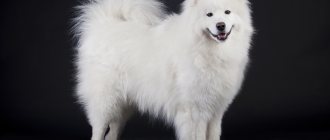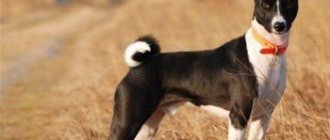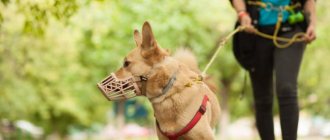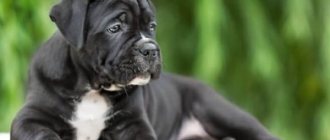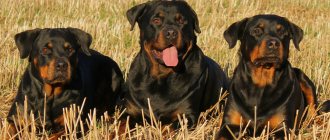Main characteristics
| Breed parameters | |
| Country of origin: | Africa |
| Weight of the breed: | males – 41-43 cm, females – 38-41 cm |
| Height at withers: | males – 10-12 kg, females – 9-11 kg |
| Temperament: | moderate |
| Wool: | short |
| Role in human life: | companion, hunting |
| Breed group: | decorative |
The African non-barking Basenji dog is a hypoallergenic breed. Despite its long history of existence, the dog came to the CIS countries quite recently. Due to its atypical habits and rumbling sounds, the pet is often compared to cats. However, these animals cannot be perceived as cute kittens. Today's indoor companions share the blood of their African hunter ancestors.
BASENJI
The first mentions of dogs of this breed are found in Ancient Egypt, approximately 2700 BC. The most ancient images of the Basenji were found in the Great Pyramid of Cheops. The images, whose history goes back to 200 BC, were found in the tomb of Antiochus II, showing 4 clear images of the silhouette of a dog. One of these silhouettes clearly resembles the modern Basenji in appearance. The hieroglyph with which this drawing is signed explains that this is a hunting dog that does not bark, unlike the other three dogs depicted nearby.
The Basenji, as we know it today, was once brought from Central Africa. It is still unknown whether these dogs came into the possession of the pharaohs as prey, or as a gift from the very heart of Africa, or maybe, on the contrary, they wandered into Africa after the fall of the power of the pharaohs. Of course, the first option sounds more convincing. The pygmies who lived in Africa were known for not accepting anything that did not belong to their culture, and since the Basenji lived with them, it is unlikely that these natural hunters adopted a dog of a foreign culture and began to hunt with it as if it were their own. .
The hunt took place according to all the rituals of the pygmies. The dogs were equipped in a certain way - rattles were hung around their necks. The dogs drove the animals into specially prepared traps in the shape of a semicircle, which were pre-constructed from stakes driven into the ground. The dogs jumped high above the ground, thereby signaling to the hunters that the task was completed and they could come to finish the job. In the tribe, Basenjis were considered sacred animals
, because thanks to them, savages could get food and survive.
And it is not surprising that during the rain, the inhabitants of the tribe gave up a place in the hut for the dogs, and during the long journey they carried them on their necks.
The found writings say that the first Europeans, in order to buy a dog, had to pay as much for it as for several wives of local leaders. Very attractive in appearance, the Basenji was considered priceless and not a single pygmy would sell it at any price. The first attempt to bring the Basenji to Europe, in 1869, ended tragically - the dog jumped out of a hotel window in Alexandria (it was a female). Another, this time successful, attempt was made in 1894, when the traveler Bogert sent the dog to an exhibition in Dortmund. This breed aroused great interest; articles devoted to it appeared in many newspapers. Her appearance at the English Cruft's Dog Show in 1895 was accompanied by a similar reaction. Unfortunately, both of these dogs died due to distemper. The dogs brought to France also could not survive. At that time, it was concluded that due to the very large difference in the climate of Africa and Europe, breeding this breed on our continent was not feasible. Only in 1908 was this streak of bad luck interrupted and the first Basenji litter in Europe was obtained in the Berlin Zoological Garden. Unfortunately, the next six dogs brought to England by Helen Nutting in 1923 did not survive due to canine distemper, and this time it was due to a bad vaccine. This was the reason that for several years it was not possible to import this breed from Africa.
Ultimately, luck finally smiled on Olivia Byrne, the wife of an English colonial official and a big fan of this dog breed. When she was in Africa, the first Basenji appeared in her house, which the woman took with her when leaving for England. The litter that was born not only survived, but was also the first to be recorded in the book of the English Kennel Club, in which these dogs were the first of their breed to be registered. But, unfortunately, after the mandatory plague vaccination, they all got sick and died, except for one bitch.
Mrs. Byrne did not give up and already in 1933 she brought a male dog to England, who after arrival covered the bitch, but, unfortunately, died three weeks later from sepsis. Despite the failure, the confident dog handler brought three animals this time: a male and two females, one of them gave birth to healthy puppies during quarantine. This was in 1937 and it was this moment that is considered the beginning of Basenji breeding in Europe.
. That same year, Olivia Byrne presented her dog at the large dog show Cruft's Dog Show. The interest in this breed exceeded all her expectations and the dog, which does not bark, created a great sensation.
The next exhibition with the participation of this breed took place in 2001. The Basenji became the most beautiful representative at the most prestigious exhibition in the world. Its success attracted attention to the breed even among dog breeders from other parts of Europe and other continents. However, so far this breed has not become very popular in Europe, and its population is still small. But in the United States, the Basenji breed quickly gained fame, and American dog breeders, despite great difficulties, managed to export several individuals from Africa for breeding, and they were able to breed representatives of the breed of the highest class.
History of the Basenji in Russia
quite short, it begins in 1997, when Elena Kurbanova brought two Basenjis from a French nursery to Moscow. So far this breed is considered not popular enough in our country, but in Europe interest in it is growing more and more, which gives us hope that their numbers will soon increase in Russia.
Basenji - history of the breed
The Basenji breed emerged as a result of the domestication of African wild dogs. Images similar to the silhouette of a Basenji were found in the Great Pyramid of Cheops. According to experts, the date of origin of these drawings is 2700 BC. In ancient times, dogs were considered sacred and revered by the aborigines. The pygmies living in Africa considered the developed instinct of a hunter to be the most valuable quality of a pet.
The veneration of a domestic animal was explained by the purpose of the dog. Using the keen sense of smell and high intelligence of the representatives of the breed, African hunters obtained food. It is known that during a long journey people carried these pets around their necks. And residents of other continents could only buy such a dog for huge sums of money.
The first attempt to bring several Basenjis to Europe failed miserably. At the end of the 19th century, travelers from Germany, France and England tried to bring the breed to their region. An unusual African dog attracted the attention of the press and dog breeders when it appeared at exhibitions. But all the pets died without taking root in the new climate. The successful start of Basenji breeding occurred only in 1908 - the Berlin Zoological Garden managed to obtain the first litter of puppies.
Olivia Byrne continued breeding animals in England. As the wife of an English colonial official, the woman visited Africa. During one of her trips, Mrs. Byrne brought several dogs. The first brood, despite their efforts, died during the plague. They tried to mate the remaining bitch after the epidemic with the imported male dog several years later, but the male did not survive due to sepsis. It was only in 1937 that healthy puppies were obtained.
Origin of the breed
The Basenji's homeland is South Africa. The history of their existence goes back no less than five thousand years. In Ancient Egypt they were considered sacred animals. Evidence of this is the drawings of Basenji ancestors on the walls of the tombs of the rulers of Egypt, as well as mummies of dogs buried along with royalty.
The natural silence of the Basenji is associated with legend. In ancient times, they knew how to talk, but their masters, the pharaohs, did not know about it. In order not to give away the secret about the hidden treasures and thereby not bring great trouble to people, the leader made a promise from the pack that they would never tell anyone what they accidentally heard.
Since then, the Basenji have remained silent. Only the eyes of a dog can eloquently speak about boundless devotion to a person.
Several representatives of the breed were brought by Europeans to Britain at the end of the century before last. However, all the animals died.
At the beginning of the 20th century, exotic Basenjis appeared in the Berlin Zoo, and in 1930 they were brought back to England. A breed standard was adopted and has never been changed. In 1937, non-barking dogs called the Congo Terrier were exhibited in the United States.
The breed, distinguished by its unique hunting qualities, attracted attention, and it became widespread throughout the world.
The Basenji breed developed independently; no breeding work was carried out on it.
Breed standard
The distinguishing features of the Basenji are forehead wrinkles and a tail curled like a donut. There are two types of dogs: plain and forest. The height and weight of the plain type are slightly greater, and their color is red and white. The forest variety is distinguished by its smaller size and black color, with darker eyes.
The Basenji standard allows for tricolor (black, white and red) and brindle colors with dark markings on the red coat.
The standard for an adult dog is as follows:
- The head is raised high, located on a long, well-arching neck.
- The skull is flat, moderately wide, tapering towards a wedge-shaped muzzle.
- The eyes are almond-shaped, slightly slanted, and have a pigmented eyelid.
- Eye color – dark brown or hazel. Black nose.
- The high-set ears have a pointed tip and stand on the head, slightly tilted forward.
- The jaw bite is scissor-shaped.
- The back is straight, the chest is of medium width and depth, and the lumbar region is short.
- The front legs are thin, straight and high. Strong shoulder blades, elbows close to the chest.
- The hind legs are more muscular in the thighs and have low hocks.
- The paws are narrow, tightly closed and slightly arched. The claws are short.
- In puppies, the tail is straight, and with age it curls into a “donut” with one or two rings.
The little pet also has more pronounced folds around the eyes and muzzle. In an adult, wrinkles are noticeably smoothed out. The lifespan of the Basenji is 12-16 years. Bitches come into heat only once a year – in the fall.
Appearance of the Basenji
Basenji is black and white with tan.
The breed is registered by the FCI under number 43. According to this classification, it is classified in group 5 - Spitz and primitive species, section 6 - primitive species. The Basenji is a harmoniously built, well-balanced animal.
Ideal height and weight:
- males – 43 cm at the withers, weighing 11 kg;
- females - 40 cm and 9.5 kg, respectively.
Head
The skull is fairly flat, of medium width, slightly longer than the muzzle. A beautifully chiselled head, the cheekbones tapering gradually and evenly towards the nose. Stop is expressed moderately. A characteristic feature is the folds-wrinkles on the forehead, which are most clearly visible if the Basenji is alert.
Eyes
The Basenji's eyes are slanted, almond-shaped, dark in color. The look is smart and very expressive.
Ears
Basenji ears are small, graceful, with sharp ends. Set on high and slightly inclined forward. The tips are closer to the center of the head than the bases.
Nose
The lobe is medium size, preferably black.
Neck
Sufficiently long, strong, but not thick. Set high. It widens slightly towards the base. The graceful curve of the neck emphasizes the scruff well.
Frame
Basenji brindle color
Harmoniously balanced. The back is straight and short. The chest with convex ribs has an oval shape. The deep chest smoothly transitions into a well-toned stomach. The loin is short.
Tail
The Basenji's tail is set high, curled into a single or double ring and laid over the croup. The buttocks protrude noticeably beyond the line of the base of the tail, which gives the impression of overdeveloped gluteal muscles.
Limbs
Front: Refined bone with long forearms. The pasterns are straight and flexible. The shoulder blades are muscular, but not heavy. Elbows point straight back.
Hindquarters: Strong and muscular, long legs. The hock joints are parallel and set low.
Paws
Basenji paws
Basenji's paws are oval, small in size, gathered into a ball. The pads are thick, the claws are short.
Wool
The Basenji's coat is short, close to the body, and shiny. The hair is soft to the touch and thin.
Color
The Basenji's color is pure black and white and red and white, black and white with melon seed tan, black and brown and white. Since 2000, the brindle color has also been recognized, and the more pronounced the black stripes, the better. White color must be present on the paws, tip of the tail and chest.
Flaws
Any deviation from the standard is assessed as a defect and becomes a disqualifying feature. The most common disadvantages of the Basenji include:
- cryptorchidism;
- long wool;
- depigmented nose, eyelids, lips;
- hanging or semi-erect ears;
- tail hanging down.
Dog character
The Basenji dog breed is not suitable for everyone. Pets are cheerful and curious, and do not show aggression towards humans. But by their nature, these animals are independent individuals. The dog does not follow the owner's instructions thoughtlessly. The Basenji's intelligence manifests itself in a high level of independence.
The pet will not rush to follow a command just to get a treat. First, the dog will think about whether it really needs it. If opinions differ with the owner, it will not be possible to force the Basenji to do the desired action. Raising a Basenji will take the owner a lot of time. Even with good training, a dog may disobey in certain circumstances.
The agility of the small dog is almost legendary. It’s worth the effort and hiding the treats in a hard-to-reach place. A smart pet can get to a table or cabinet by jumping onto a lower piece of furniture nearby. With their agility, the animals are reminiscent of cats - a dog even washes itself with its paw, like a cat.
History of the breed
The Basenji is included in the list of the 14 most ancient dog breeds on earth and the history of the breed goes back about 5,000 years. Endurance, compactness, strength, speed and silence made it a valuable hunting dog for African tribes.
They used them to track, pursue, and guide the beast. For thousands of years they remained a primitive breed, their color, size, body shape and character not controlled by man.
However, these qualities did not save the weaker representatives of the breed from death during a dangerous hunt and only the best survived. And today they live in the pygmy tribes (one of the oldest cultures in Africa), almost the same as they lived thousands of years ago. They are so valuable that they are worth more than a wife, have equal rights with the owner and often sleep inside the house while the owners sleep outside.
Edward C. Ash, in his book “Dogs and Their Development,” published in 1682, described a Basenji he saw while traveling in the Congo. Other travelers also mentioned it, but the full description was compiled in 1862 when Dr. Dr. George Schweinfurth, traveling in Central Africa, met them in a pygmy tribe.
Initial attempts to breed were unsuccessful. They first came to Europe via England in 1895 and were introduced at the Crufts' Show as the Congo Bush Dog or Congo Terrier. These dogs died of distemper shortly after the show. The next attempt was made in 1923 by Lady Helen Nutting.
She lived in Khartoum, the capital of Sudan, and was intrigued by the small Zande dogs she often encountered during her travels. Having learned about this, Major L.N. Brown (LN Brown), gave Lady Nutting six puppies.
These puppies were purchased from different peoples living in the Bahr el Ghazal region, one of the most remote and inaccessible parts of Central Africa.
Deciding to return to England, she took the dogs with her. They were placed in a large box, secured on the upper deck and set off on a long journey. This was in March 1923, and although the weather was cold and windy, the Basenji endured it well. After arriving they were quarantined and showed no signs of illness, but after vaccination they all fell ill and died.
It wasn't until 1936 that Mrs. Olivia Burn became the first breeder in Europe to breed Basenjis. She introduced the litter to the Crufts' Dog Show in 1937 and the breed became a hit.
She also wrote an article, “The Barking Dogs of the Congo,” which was published in a newspaper published by the American Kennel Club. In 1939, the first club was created - “The Basenji Club of Great Britain”.
The breed appeared in America thanks to the efforts of Henry Trefflich in 1941. He imported a white male named 'Kindu' (AKC number A984201) and a red female named 'Kasenyi' (AKC number A984200); these and four more dogs that he would bring later would become the ancestors of virtually all dogs living in the United States. This year will also be the first in which they have been successfully bred.
The unofficial debut in the United States took place 4 months earlier, on April 5, 1941. A little girl, later nicknamed Congo, was discovered in the hold of a cargo ship carrying goods from West Africa.
A very emaciated dog was found among a cargo of cocoa beans after a three-week journey from Free Town to Boston. Here is an excerpt from an article published April 9 in the Boston Post:
On April 5, a cargo ship from Freetown, Sierra Leone, arrived at the port of Boston with a cargo of cocoa beans. But when the hold was opened, there were more than just beans. A female Basenji was found in an extremely emaciated state after a three-week trek from Africa. According to crew reports, as they loaded cargo in Monovia, two non-barking dogs were playing near the ship. The crew thought that they had escaped, but apparently one of them hid in the hold and was unable to get out until the end of the voyage. She survived thanks to the condensation that she licked from the walls and the beans that she chewed.
The Second World War interrupted the development of the breed both in Europe and the USA. After its completion, Veronica Tudor-Williams helped give impetus to development; she brought dogs from Sudan in order to renew the blood. She described her adventures in two books: Fula—Basenji from the Jungle and Basenjis, the Barkless Dog. It is the materials of these books that serve as a source of knowledge about the formation of this breed.
The breed was recognized by the AKC in 1944, during which time the Basenji Club of America (BCOA) was established. In 1987 and 1988, John Curby, an American, organized a trip to Africa, the purpose of which was to obtain new dogs to strengthen the gene pool. The group returned with brindle, red and calico dogs.
Until that time, the brindle-colored Basenji was not known outside of Africa. In 1990, at the request of the Basenji Club, the AKC opened a stud book for these dogs. In 2010, another expedition was undertaken with the same purpose.
The breed's history has been tortuous and complicated, but today they are ranked 89th in popularity among all 167 breeds in the AKC.
Basenji training
Raising a Basenji is difficult, but possible. The worst relationship for your pet is with the “Come to me” command. Sometimes a dog stops hearing its owner if it gets carried away chasing small animals. It is strictly prohibited to punish a pet for its hunting nature.
The question of how to raise representatives of this breed is relevant for many dog breeders. The first step is to learn everything about the Basenji. The puppy is highly intelligent. This is both a plus and a minus in the learning process. The animal remembers commands perfectly, but will not carry them out for nothing.
There are two main mistakes when training a Basenji:
- The owner expects obedience, as from a service dog. You shouldn’t expect a pet to “toe the line.” Many owners like the character and features of the breed. If obedience comes first, it is better to choose another pet.
- The owner lets everything take its course and does not work regularly. Without training, the dog begins to act in its own way. You shouldn't blame your pet for this. If there is insufficient persistence, the dog will feel that training is unnecessary. Therefore, the commands may not be executed.
Education should take place in the form of a game, and be sure to give encouragement in the form of treats. A Basenji should see its owner not only as a leader, but also as a best friend. If you offend a dog, it will take a long time to restore his trust.
Basenji content
Keeping a Basenji dog is quite difficult. She needs to be bathed often (and the dog is afraid of water), she sheds moderately, but she needs to be walked a lot. Moreover, it should not be an aimless walk lasting 20 minutes. Walks should be long, including exercises, overcoming obstacles and various games.
If the walk is not in a closed area, but around the city, then you cannot let the cunning and agile Basenji off the leash - he will run away in search of adventure. Representatives of this breed love to chase cats, communicate with stray dogs, and eat leftovers.
Basenjis can be kept both indoors and outdoors. If the second option is preferable, then you need to take all measures to ensure that the dog feels comfortable and cannot run away: make the highest possible fence, equip an enclosure, an insulated booth, etc.
Basenjis do not tolerate frost well, so when taking your dog for a walk in the cool season, it is advisable to put on overalls.
Great importance is attached to nutrition. Food from your own table is prohibited! The best option is to use professional elite feed. If preference is given to “natural” meat, then the basis of the diet should be raw meat.
Dog care and maintenance
Caring for a Basenji does not require much effort. The hypoallergenic dog has short hair and is clean by nature. The pet washes itself, like a cat. But you need to wipe the wool once a week with a damp cloth.
Bathing Basenjis is prohibited: these animals do not tolerate water. It is believed that the fear of water in pets arose due to crocodiles that live in the dog’s homeland.
You can keep a pet in an apartment only if there is a lot of physical activity every day. Most of all the dog loves to run. You need to walk with your pet as much as possible - without activity, the Basenji will not feel good.
Care and maintenance
The Basenji is a dog that can be kept both in a city apartment and in a country house.
Basenji with a child
Taking care of her is not at all difficult. The smooth-haired “African” does not need to be brushed and combed; its fur does not have a characteristic dog smell at all, even if it is wet. Puppies will require a little more attention - their skin needs to be combed from time to time, removing dead hairs.
Walking, active and active at that, is very necessary for the “Congolese” for harmonious development and growth.
In both adult dogs and puppies, do not forget to constantly monitor the condition of the nails and ears. Regularly clean the ears of dirt and secretions with a cotton swab, and trim or carefully file down the claws as necessary.
Basenjis love to wash themselves and do it almost like a cat, so their faces are always clean and well-groomed (even if they recently got into something sticky), and you don’t have to worry about the cleanliness of upholstered furniture or carpets in the house. But these dogs do not like water, so bathing them is not recommended. The persistent aversion to water procedures is associated with the genetic memory of the breed, namely the fear of crocodiles, which are found in almost any African river.
Basenjis have an amazing talent for climbing (and very quickly) to any height. If the puppy understands that the dinner table is a source of treats and treats, it will be impossible to keep track of him and keep him from mischief. Immediately teach the nimble and active “African” to eat in a strictly defined place. Under no circumstances give in to attempts to beg food from you, no matter how funny and cute the puppy makes.
Proper dog care involves organizing a balanced diet.
The Basenji's diet should not be monotonous. Try to add new products to the menu whenever possible. By the age of one and a half months, the baby of the “bush dog” should eat veal, raw quail eggs, kefir, oatmeal, and grated carrots from vegetables. You can alternate natural products with specialized and age-appropriate premium dry food.
Don't forget about a bowl of clean, fresh water. The dog should not be thirsty.
Food from our table is contraindicated for an adult animal, as well as a puppy. Sweets, spicy foods, fish bones and long bones can cause serious harm to your pet's health. You cannot overfeed your dog. The Basenji is a natural hunter, and the feeling of slight malnutrition is absolutely natural for him.
Common diseases
An animal with good heredity should not have any special health problems. But some diseases are typical for pets.
Common ailments include:
- hip dysplasia;
- intestinal malabsorption;
- hypothyroidism;
- retinal atrophy;
- umbilical hernia.
It is also possible to have a hereditary eye disease, coloboma. Fanconi syndrome, a rare disease that causes kidney problems, can also be inherited.
Pros and cons of the breed
The characteristics of the breed have its own advantages and disadvantages. Summarizing the information presented, we will highlight the key points in the “pros” and “cons” columns.
Pros:
- high intelligence;
- lack of aggression towards people;
- suitable for apartment;
- hypoallergenic wool;
- minimal care;
- no noise.
Minuses:
- tendency to disobedience;
- strong hunting instinct.
Knowing everything about the breed of the dog being purchased is the duty of every owner. Being aware of the shortcomings of the future pet, a person will be able to make an informed final decision.
Character
Intelligent, independent, active and resourceful, Basenjis require a lot of exercise and play. Without sufficient physical, mental and social activity, they become bored and destructive. They are pack dogs that love their owner and family and are wary of strangers or other dogs on the street.
They get along well with other dogs in the family, but will chase small animals, including cats. They get along well with children, but to do this they must communicate with them from childhood and be well socialized. However, like all other breeds.
Due to the special structure of the larynx, they cannot bark, but do not think that they are mute. They are best known for their purring sound (called "barroo"), which they make when excited and happy, but they can be forgetful when alone.
This is a proud and independent breed, which may be off-putting for some people. They are not as sweet as most other dogs and are much more independent. The downside of independence is stubbornness, plus they can be dominant if the owner allows it.
They need early, methodical and firm training (not harsh!). They perfectly understand what you want from them, but they can ignore commands. They need incentive, not screaming and kicking.
You should not walk without a leash, as their hunting instinct is stronger than their mind; they will rush in pursuit of a cat or squirrel, regardless of the danger. Plus, their curiosity, agility and intelligence get them into trouble. To avoid these, check your yard for holes in the fence and digs, or better yet, keep the dog indoors until she is two years old.
Basenjis do not like cold and wet weather, which is not surprising for African dogs and how African meerkats can stand and stand on their hind legs.
Average price of puppies
Choosing a puppy is a responsible undertaking. You should take the animal from a kennel to get a healthy dog without hereditary diseases. Before 1.5 months, you cannot take the baby away from the mother. The optimal age is 8 weeks.
Basenji puppies should be active, have healthy ears and teeth, and a pink mouth. Dog breeders recommend taking the calmest puppy if the future owner is a beginner. Such an exotic pet will cost 15-20 thousand Russian rubles. The price for a puppy with a pedigree for exhibitions can rise to 50 thousand and above.
Description
Basenjis are small, short-haired dogs with erect ears, tightly curled tails and graceful necks. There are pronounced wrinkles on the forehead, especially when the dog is excited.
Their weight ranges from 9.1–10.9 kg, height at the withers is 41–46 cm. The body shape is square, equal in length and height. These are athletic dogs, surprisingly strong for their size. The coat is short, smooth, silky. There are white spots on the chest, paws, and tip of the tail.
- Red with white;
- black and white;
- tricolor (black with red and tan, with markings above the eyes, on the muzzle and cheekbones);
- brindle (black stripes on a red-fawn background)
